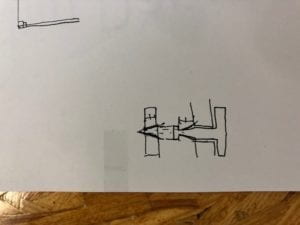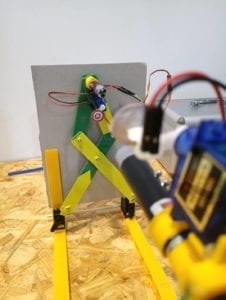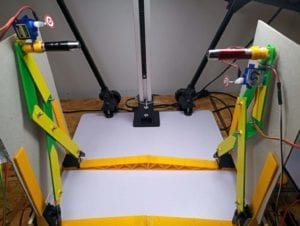Individual Reflection
Context and Significance:
If we trace our final product, “Laser Arcade,” back to the planning period, it may be surprising that it did not even exist. Immediately after the Group Project, Daniel and I began brainstorming ideas for our Midterm Project. Daniel, who has much more experience in computer programming than me, had an idea to create a sort of virtual interface that users could play a simple game on using a remote (kind of like the Wii). However, we agreed that I would be fairly useless in such a task, so we scrapped that idea. It was only after the recitation with the drawing arms and servos that we finally knew what we wanted to do.
I researched some arcade games before finally (and strangely) arriving at the alien game Gru and the girls play in Despicable Me.

From there, we transitioned from working together to playing against another player. Although the original idea was good and the level of interaction would be similar, the competitive nature proved much more exciting. I have been to many arcades in the US and have seen many similar games. However, most of the games register “hits” and “misses” with programmed coordinates rather than sensors. Since we had the sensors available, we decided to do that instead (also, the coordinate system would have burdened Daniel because I have no experience in that area). This project is intended for any two players looking for competitive fun. The laser pointer allows the player to easily identify where he/she is aiming and adjust accordingly, making it easier to control than other “shooters.”
Concept and Design:
Originally, we expected to have a list of rules for players to read prior to playing. However, we later reasoned that an arcade game should be clear and intuitive, and we shifted our design accordingly. We decided to limit ourselves to “Player 1” and “Player 2” signs to give the players a starting point. We included knobs for players to intuitively grasp and test, as well as including a winning sound and winning/losing animation for each player.

Audio Cue:
Winning/Losing Animation:
As far as materials, we decided to simply save time and use the same green drawing equipment as in the recitation. In addition, we decided to use the ambient light sensor from our Arduino kits. We tested other sensors, but most of them were either too large or not sensitive enough (meaning the room light would almost max out the threshold). Our use of servos was inspired by the same recitation, and we saw no reason to replace them. The cardboard seen in the above footage was simply for the prototype; the final product was 3D printed, as I will show in the next section.
Fabrication and Production:
The first step in our project was writing the code. Although I did not contribute much to this aspect, I did what I could. Daniel explained to me what he did and why; although I cannot replicate it, I understand its function.
The next part was building the first testable prototype. This step took a lot more time than we anticipated due to unforeseen difficulties. For example, one of our servos unexpectedly stopped working (after we glued it together, of course). In addition, we had to 3D print a few small gadgets to facilitate the process:





The cardboard set up we developed was only changed after the User Testing Session (mostly due to time management). This session also illuminated previously unknown problems with our design. Most commonly, players did not seem to understand the objective of the game. They understood they could control their lasers, but not where to aim. In response, we added a target around the light sensor.


Next, we realized players were not turning the controls as we intended: they were using them as two joysticks instead (this caused one potentiometer to break, further complicating the project.
To fix this issue, we took Marcela’s suggestion and 3D printed controls that looked like car radios, which everyone should know to rotate (as seen in the video above). The last thing we had to do was take apart the entire project and recreate it on the printed base. With precise measurements, Daniel and I completed this surprising quickly, and here are the results:



Conclusions:
The goal of our project was to create a two player game that requires each player to hit a target with a laser while simultaneously avoiding the other player’s laser. According to our definition of interaction, this project is highly interactive. The arms move in response to a player’s inputs, and according to their position, the player then readjusts accordingly. Furthermore, there is player-to-player interaction. The players are each responding to the actions of the other and making decisions based on the movements of the other player. However, one of the instructors pointed out (I don’t recall who), the game could be altered to a cooperative game rather than a competitive one. Again, we considered this but ultimately chose not to go down that path simply out of preference. Both concepts are equally interactive, but the competitive one was easier to imagine and build.
After the User Testing Session, we unfortunately did not have much time for further testing. The presentation went well, and the few who tested it understood the objectives and mechanics of the game. If we could do the project again, perhaps we would opt for the cooperative game. We would definitely be certain to test all our servos before gluing them to anything. We would also be more creative with the base. We wanted to include art/stickers typically seen on arcade machines but simply did not have the time to add them. From our accomplishments, I gained the knowledge that I can do much, much more than I originally thought I could do. Never did I think I would be able to 3D print such complicated gadgets or understand a more than a basic code. This opened a gratifying door for brainstorming final project ideas. The process of creating this has set a new standard for me, as far as future projects.
Lastly, our project shows that arcade games can be some of the most interactive forms of entertainment available. Laser Arcade brings forth aspects of interaction that are slowly fading away. Because our virtual world is rapidly expanding, many young people use the internet to connect with one another. Besides sports (which are physically taxing or require specialization, and therefore not for everyone), real-world competitive activities are almost exclusively virtual. In other words, our project revives competitive interaction for anyone willing to use it.
Very engaging writing skill there!